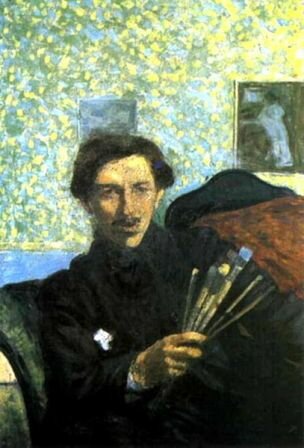One of these following facts about Umberto Boccioni might probably give you much information about him. Umberto Boccioni, as you know, was an influential Italian painter and sculptor. Despite his short life, his approach to the dynamism of form and the deconstruction of solid mass guided artists long after his death. His works are held by many public art museums, and in 1988 the Museum of Modern Art in New York organized a major retrospective of 100 pieces. To get to know more about him, here are some other facts about Umberto Boccioni you might like.
Facts about Umberto Boccioni 1: Early Portraits and Landscapes
From 1902 to 1910, Boccioni focused initially on drawings, then sketched and painted portraits – with his mother as a frequent model. He also painted landscapes – often including the arrival of industrialization, trains and factories for example.
Facts about Umberto Boccioni 2: 1909-1910
“The Morning” (1909) was noted for “the bold and youthful violence of hues” and as “a daring exercise in luminosity.” His 1910 “Three Women”, which portrays his mother and sister, and longtime lover Ines at center, was cited as expressing great emotion – strength, melancholy and love.
Facts about Umberto Boccioni 3: “Labor”
Initially titled “Il Lavaro” (Labor), Boccioni worked for nearly a year on “La Citta Sale” or “The City Rises”, 1910, a huge 2mx3m painting, which is considered his turning point into Futurism. Upon its exhibition in Milan May 1911, the painting attracted numerous reviews, mostly admiring. By 1912 it became a headline painting for the exhibition traveling Europe, the introduction to Futurism.
Facts about Umberto Boccioni 4: “The Laugh”
“La Risata” (1911, The Laugh), is considered his first truly Futurist work. He had fully parted with Divisionism, and now focused on the sensations derived from his observation of modern life.
Facts about Umberto Boccioni 5: Trilogy of Paintings
Boccioni spent much of 1911 working on a trilogy of paintings titled “Stati d’animo” (States of Mind), which he said expressed departure and arrival at a railroad station – The Farewells, Those Who Go, and Those Who Stay. They are cited as defining the vastness and infinite possibility of Futurist painting and sculpture, and liberated from the academic frigidity of Cubism.
Facts about Umberto Boccioni 6: Sculpture
The writing of his “Manifesto of Futurist Sculpture”, published in April 1914, was Boccioni’s intellectual and physical launch into sculpture. Unfortunately, much of his experimental work from late 1912-1913 was destroyed, including pieces relating to contemporaneous paintings, which are known only through photographs.
Facts about Umberto Boccioni 7: Futurist Exhibitions
Boccioni took part in all the important futurist exhibitions in Europe and America, beginning with the Paris exhibition of 1912. His book “Pittura, scultura futuriste: Dinamismo plastico” (1914) is the most comprehensive statement of futurism written by one of the original members of the movement.
Facts about Umberto Boccioni 8: 1912-1913
Only “Development of a Bottle in Space” (1912) successfully creates a sculptural environment. His most famous work, “Unique Forms of Continuity in Space” (1913), is one of the masterpieces of early modern sculpture.
Facts about Umberto Boccioni 9: Death
Boccioni enlisted in the army during World War I and was killed by a fall from a horse in 1916. He was the most talented of the Futurist artists, and his untimely death marked the virtual end of the movement.
Facts about Umberto Boccioni 10: Meeting with Filippo Marinetti
To Boccioni’s searching spirit the meeting with the poet Filippo Marinetti in 1909 was an event of the utmost importance. Marinetti, the initiator and great orator of the futurist movement, converted Boccioni to his principles.
Hope you would find those Umberto Boccioni facts really interesting and useful for your additional reading.










 www.PortlandPayday.Loans
www.PortlandPayday.Loans